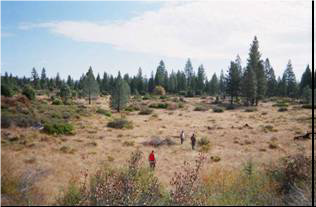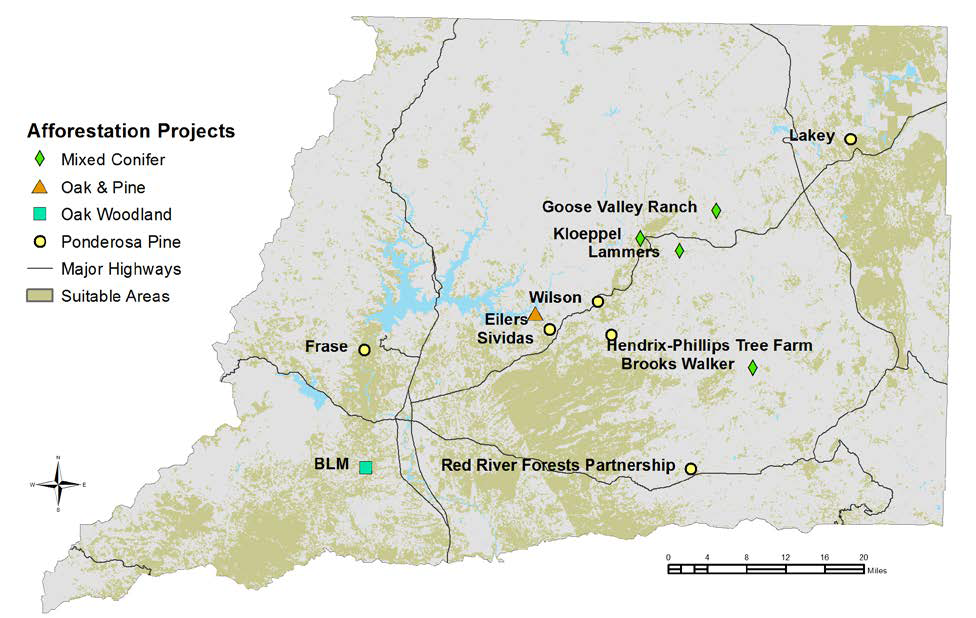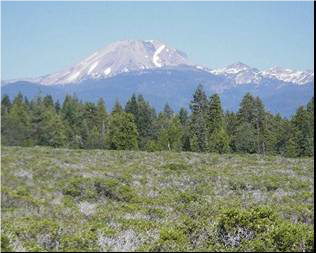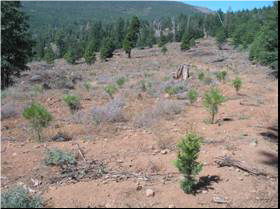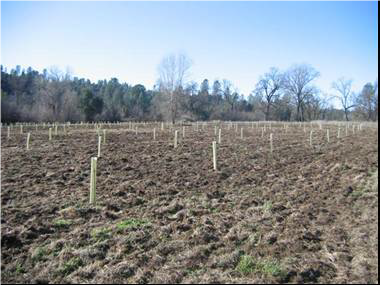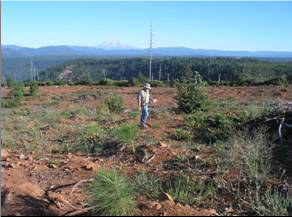Carbon Storage Atlas
Shasta County Terrestrial Pilot
Lat/Long:
Shasta County, California (40.956594, -122.180634 Regional)
Why This Location?
Shasta County, California, as well as Lake County, Oregon, were chosen for Phase II terrestrial pilot project sites because Phase I characterizations found they offered a chance to test storage opportunities broadly available throughout the West Coast Regional Carbon Sequestration Partnership (WESTCARB) region. Phase I characterization work and other studies indicated that afforestation represents the largest single terrestrial carbon storage opportunity across the WESTCARB region. Through suitability modeling, it was found that approximately 80% of Shasta County rangelands would be potential candidates for afforestation. Shasta County also offered a diversity of land types and site conditions created by the various elevations, slopes, climates, and vegetation types within the County. The afforestation pilot projects comprised 476 acres under 12 landowner agreements.
Main Research Q&As Discovered
The objectives of the Shasta County afforestation Phase II pilot were to refine the Phase I economic analysis for afforestation with improved cost data, gain field experience with afforestation projects, refine carbon estimates for afforestation, and gain experience with landowners and potential business partners. Project baselines consisted of a variety of brush species, mostly in dense stands. Projects were planted with ponderosa pine, mixed conifer stands, or native oaks. Projections of net carbon stocks over 100 years on conifer plantings ranged from approximately 53 metric tons of carbon per acre to 111 metric tons of carbon per acre. The native oak planting had projected net carbon stocks of approximately 24 metric tons of carbon per acre after 100 years. Survival of planted conifer seedlings was high, despite limited rainfall in the year of planting. Project costs ranged from $354 per acre to $1,880 per acre. Project costs depend on baseline conditions, accessibility, quality of the site, and resulting tree growth. Sites with low carbon stocks in the baseline resulted in net-positive results within the first 10 years and store larger amount of carbon over the project lifetime. Those areas with high site quality result in large net increases in carbon stocks, although even in areas with poor site quality and limited rainfall, seedling survival was high, and projected carbon stocks can be significant. After 80 years, approximately 52.3 million metric tons (57.6 million tons) of carbon could be economically stored on approximately 57% of suitable rangelands in Shasta County. The studies found that landowners have a strong interest in afforestation projects.
Lessons Learned that Impacted Phase III Design?
The Shasta County terrestrial storage pilot did not lead to a large-scale Phase III demonstration project on afforestation as part of the U.S. Department of Energy’s (DOE) Regional Carbon Sequestration Partnership (RCSP) Program. However, results of the Shasta County pilot contributed to the development of a Regional Technology Implementation Plan (RTIP) for terrestrial storage. The Shasta County pilot showed that public perception of terrestrial carbon storage is generally positive when it accords with land-use practices such as conservation and restoration, and many landowners are motivated to undertake projects both as a means of generating income and to improve the state of their lands. Results also showed that afforestation of rangelands and past fire sites had the potential to make a significant contribution to California’s efforts to meet its greenhouse gas (GHG) reduction goal. In order to achieve this goal, the RTIP identified challenges that need to be addressed for full-scale deployment of terrestrial storage.
Story of Interest
The Shasta County terrestrial storage pilot project was unique to the West Coast Regional Carbon Sequestration Partnership (WESTCARB) due to its specific focus on afforestation of rangelands and past fire sites. While public support for any type of carbon dioxide (CO2) storage project is often hard to gain and involves a lot of outreach and education, the Shasta County landowners were very interested in participating in and conducting afforestation on their land and many were willing to share costs for the project. These land owners were motivated by the prospect of creating multiple revenue streams from their land, a personal desire to mitigate climate change, and the opportunity to improve forest health and mitigate fire risk. Many sites were brush-covered areas that acted as wildfire fuel. The pilot projects removed the invasive brush and planted oak or conifer trees to capture carbon and diversify the forest system in the area. Afforestation provides co-benefits to the region through the reduction of fire risk by interrupting the “brush and burn” cycles, the creation of a healthier and more diverse forest, and the production of timber and biomass through logging and wildfire fuel-load reduction. An additional climate adaptation benefit is if afforestation projects are located near upper watersheds, the additional foliage and deep root systems can help regulate water availability and reduce flooding risk for consumers and ecosystems downstream.





